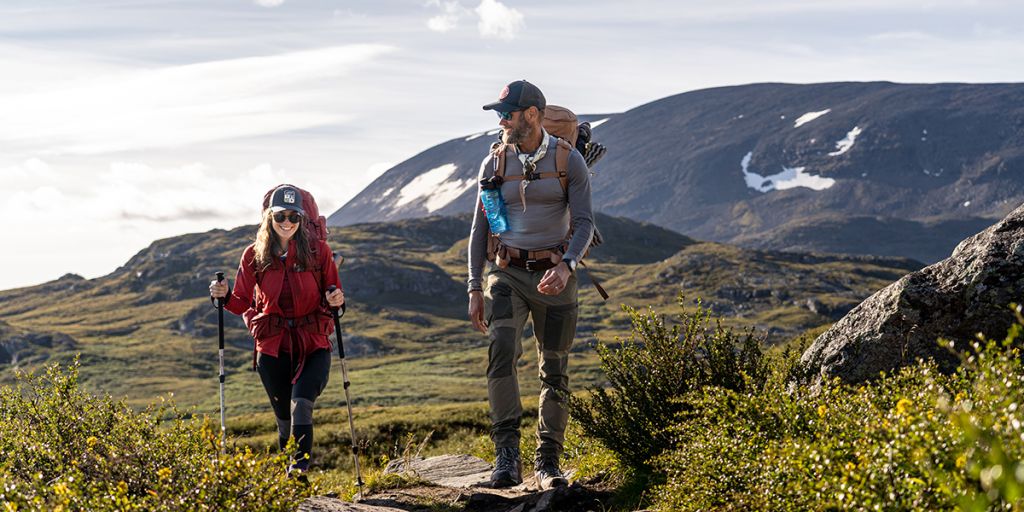How to pack for a multi-day trek?
Find out what Global Event Manager Carl Hård af Segerstad packs for a few days and nights on the trail.
Trekking on your mind? Maybe you’re taking part in your first Fjällräven Classic? There’s no better time than the present to plan out your packing strategy.
Global Event Manager Carl Hård af Segerstad is happy to help. Better known as “Calle” in the Fjällräven offices, he is an outdoorsman to his core and oversees popular events like Fjällräven Classic and Fjällräven Polar. He knows trekking, and we can’t think of anyone better to tell us how to pack for a few days and nights in nature.
His advice is suitable for “typical” short treks in temperatures between 10 to 30° Celsius, and weather ranging from sunny and warm, to rainy and windy. Just the kind of conditions you can expect in spring, summer or fall, and on the 2023 Fjällräven Classic circuit.
What should I wear?
Before digging into Calle’s backpack, consider what to wear. While ensuring you have everything needed for comfort, you should aim for minimalism and multi-functional garments.
Calle’s advice? Layer to ensure optimal comfort for varying conditions and activity levels. Doing so lets you regulate your body temperature, which changes frequently on the trail. A merino wool base layer will feel comfortable against your skin and provide the dual functionality of keeping you warm and dry. To provide thermal insulation, Calle turns to fleece as a mid layer and a light insulation jacket to put on in the evenings. A shell layer is a non-negotiable for protecting against rain.
On his bottom half, Calle wears zip-off trousers, which have the added benefit of converting into shorts when needed. He also always wears his well-worn leather trekking boots, which have been with him through many adventures. For him, the best thing about traditional leather trekking boots is if they are broken in you will be very comfortable. As he says, “You can go lighter, but this is the safe choice.”
Calle also pays attention to proper foot care. He wears two pairs of socks (thin liner socks and thick woollen socks), swearing that the combination is the best protection from blisters. He is also a fan of wearing a comfortable pair of sandals at camp so his feet are in the best shape for the next day.
Calle also recommends packing an additional base layer, a windbreakers, a pair of long johns and a spare set of socks in a waterproof bag.
Finally, he wears a cap to protect from the sun and rain. It also has the added benefit of hiding a bad hair day on the trail!

What should I carry in my backpack?
To ensure a comfortable night’s sleep on the trail, Calle likes a three-person tent, but recommends sizing down or up as needed. In warmer temperatures, he says that a two- or three-season sleeping bag will suffice, and combines it with a lightweight, inflatable sleeping mat. It is important to note that he packs both inside a waterproof bag to keep these essentials dry.
Calle also asserts that keeping things organised inside your backpack is the key to packing well, and likes using pack bags to keep like items together. In one gear bag, he includes both a first aid kit and toiletries. In another bag he stories cutlery, a head lamp and other essential equipment. Food and snacks also deserve their own bag. On a short trek, Calle opts for freeze-dried food which is weight and calorie efficient, but also suggests bringing along a few treats. To cook, you need a stove and its accompanying gas canister.
Finally, it is vital to bring one (at least) one-litre water bottle, and if the environment allows, a water filter is great for drinking from sources found on the trail. Another firm favourite for Calle is a water bag, which allows him to carry a substantial amount of water to his tent in one go.
And what does he pack it all in? Calle depends on his tried-and-true Keb 52 backpack, but any lightweight trekking model will do the trick.

Calle’s Classic checklist
Clothing
- x2 merino wool upper base layers
- Shell jacket
- Mid layer
- Merino wool long johns
- Trekking trousers
- Insulation jacket
- Windbreaker
- Basecamp shoes (like sandals)
- Leather trekking boots
- x2 thin liner socks
- x2 heavier wool knit socks
Gear
- Cap and/or hat
- Working gloves
- Sunglasses
- Water bag
- Headlamp
- Towel
- Cloth (for wiping off moisture from the tent)
- Multi-tool
- Water bottle
- Water filter
- Stove and gas
- Cutlery
- Cup
- Food (unless you’re packing for Classic, in which case, we got you!)
- Tent
- Two-season sleeping bag
- Sleeping mat
- Backpack
- Waterproof bag
- Personal hygiene items (toothbrush, toothpaste, small soap)
- Toilet essentials (toilet paper, small garden shovel and/or WAG bag for disposing waste)
- First aid kit (bandages, plasters, painkillers)
- Sunscreen
- Ear plugs
- Hand sanitiser
We think Calle’s lists – which he has developed over years of outdoor adventures – are top notch, but it is vital to hone your own to your personal needs and the type and length of your trek.
Nature is waiting, and now is a better time than ever to prepare for future outdoor adventures.
